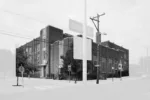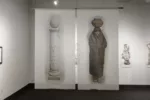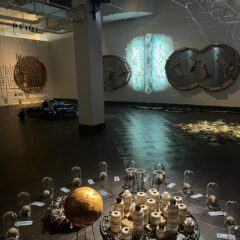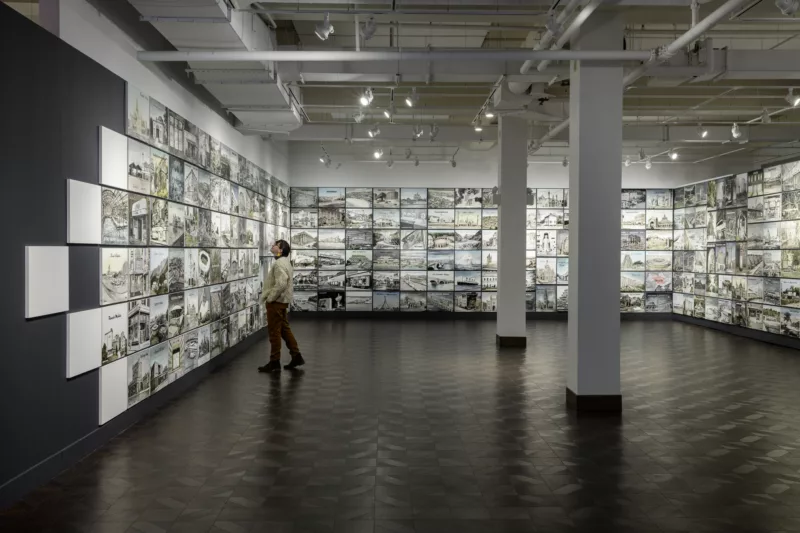
I have just seen Ellen Harvey’s The Disappointed Tourist, now at the Rowan University Art Gallery and Museum in Glassboro, NJ, and I can’t stop thinking about it. The exhibition–over 300 paintings– fills three walls of the gallery space, each wall comprising a grid of monochromatic acrylic paintings (black and white) on wood panels, 24 x 18 inches. It is an exhilarating show depicting things that have disappeared from the earth, a tribute to tragic loss and nostalgic memories that demonstrates the triumph of art over failure and defeat. Each of the paintings is based on a pre-existing image, typically a postcard or photograph, and all are based on ideas and images sent to the artist in response to the call: “Share with us a place you want to visit that no longer exists.” The project has been touring the world since 2019, when it started in pre-Covid Milwaukee, with subsequent stops in Austria, Poland, England and Ireland, and now in New Jersey. With every stop, Harvey adds new paintings in response to local suggestions, so that with each iteration the global network of memory expands.
Some of the images are rooted in everyday life (corner stores, swimming pools, amusement parks, libraries, factories), while others feature the lost monuments of Syria, Iraq, Greece, encompassing mosques, synagogues, churches, and monasteries. There are destroyed arches commemorating unknown triumphs and mythical sites like the Lost Atlantis and the Colossus of Rhodes; and there are the ongoing ruins of climate change– e.g., the Chacaltaya Glacier in Bolivia and the Great Barrier Reef of Australia. There are the imagined Hanging Gardens of Babylon, and eight pictures of famous trees. The paintings emulate postcard style, but Harvey varies her technique, from loose sketch to sharply detailed rendering, depending on subject. You find yourself constantly wanting to study each painting, even while your peripheral vision is pulling you into adjacent images. The result is an exciting and unfamiliar battle within the viewer’s consciousness: where shall I look next?
Because Harvey is crowd-sourcing her subjects, there’s a randomness about the collection that is part of its charm, creating weird juxtapositions — e.g., the Parthenon next to a ski jump and above a corner luncheonette in New York City. But there are also deliberate arrangements, clusters of related imagery that provoke the viewer to reflect on the poetry of neighboring juxtapositions — as with the proudly pictured Titanic, placed below an iceberg; or a Howard Johnson restaurant next to the Bastille, which sits above a Parisian bridge with hundreds of locks attached to a side wall. And there are several other paintings that don’t fit anywhere–documenting the dreams of determined “outsider” visionaries–like a backyard shell garden in the UK that took 40 years to construct, and its upstairs neighbor on Harvey’s wall, a San Francisco building with furniture seemingly “thrown out” of the windows and frozen in place (it’s called “Defenestration“), a neighborhood landmark for 17 years. The irony of these juxtapositions is Harvey’s of course, as is the original selection of images she chooses to paint from the multitude of requests she receives.
In short, The Disappointed Tourist is a collaborative archive of the world we have lost, a masterpiece of conceptual art modeled on the idiom of vernacular commercial art — tourist postcards and popular photography. It is also an eccentric survey of world history, architecture, popular culture, religious civilization, and everyday life. (Harvey’s website includes a brief researched summary of each image written by the artist, along with a message from the “contributor” explaining what motivates their proposal; reading these program notes adds yet another dimension to the project.)
Ellen Harvey — born in the U.K. and for many years a New Yorker — is a conceptual artist who, following a brief law career (J.D., Yale), has been bringing her art to the streets and public places for the past twenty-five years. Though possibly not a household name, she’s had countless shows, including the Barnes, PAFA, the Whitney and throughout Europe; and there are, so far, four books about her work. She’s done several large-scale public works, including commissions for the Philadelphia Airport, transit systems in New York and Chicago, and public buildings. In fact, Harvey began her career by commissioning herself, in effect, to paint miniature oval-shaped picturesque landscapes throughout New York City, on a wide range of graffiti sites, from buildings to lampposts (New York Beautification Project, 1999-2001). And in 2001, at various locations in New York, she set up her easel and executed 15-minute pencil portrait sketches and gave them as gifts to her subjects in exchange for their writing a brief response to the drawing.
But the main recurring obsession in Harvey’s work is the museum itself, the space of the collection, the way art is hung and looked at, and throughout her career she has explored the limits and dynamics of viewing art–space, framing, illusion, distance, juxtaposition. And virtually everything she’s done (except for the street portraits) has been based on pre-existing visual representations.
Harvey builds on and continues the legacy of Duchamp (especially his Box in a Suitcase), Marcel Broodthaers’s Museum of Modern Art, Department of Eagles, and Warhol’s grid variations on the mass image. You will also see affinities with Ed Ruscha’s deadpan archaeology of contemporary urban space, and with other artists (Allan Sekula, Martha Rosler, John Baldessari) who have incorporated an irony about the process of art-making into the work itself. That self-reflective habit of mind, which seems postmodern, has its own glorious history, reaching back to the early 17th century paintings of paintings densely populating the walls of galleries. Harvey is as steeped in art history and the history of aesthetic perception as David Hockney (in Cameraworks), but she adds a fourth dimension: her work is about the space of the museum and about the eye of the artist, but it’s also about the viewer who confronts the artwork.
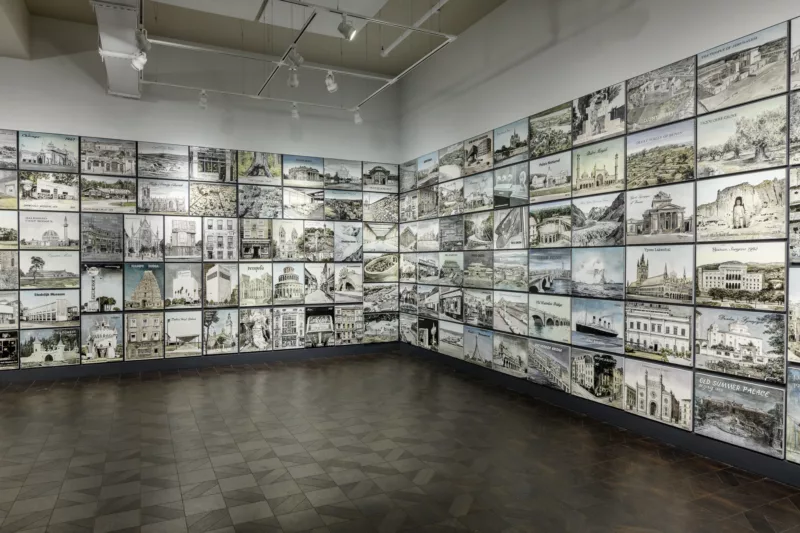
What is further distinctive about Ellen Harvey is the universality of her major theme — precarity and loss. Her work is morally serious without being ponderous; it is intellectually complex without being esoteric. We live in a world of change, and dealing with that fact is the major human challenge that is at the center of The Disappointed Tourist. (The idea of the “irreplaceable” object surfaced in her work as early as 2008, in a series of post-Katrina paintings, The Irreplaceable Cannot Be Replaced, that invited New Orleans people to submit descriptions of “places, people, or things” lost in the flood.) In the years since Katrina, in a hundred ways, it’s become evident that the erosion, disappearance, vanishing, melting, incineration, evaporation, the violent destruction of the world we once thought of as stable, is the central fact of the 21st century.
As I drive back to Philadelphia over the Ben Franklin Bridge, I think– Oh gee, I should have taken the Walt Whitman! Not because of traffic or distance, but in deference to the bridge between America’s greatest poet and possibly the most Whitmanesque of contemporary American visual artists, whose ability to conjure the world in single images and to create an immense encyclopedia of things that are gone from the earth, is so like Whitman’s exuberantly comprehensive catalogs. But Whitman was recording what was all around him, and he assumed, if you recall Crossing Brooklyn Ferry, that the world would continue on and on into the future; Harvey (who happens to live in Brooklyn) is recording in pictures the world we have lost and are losing every day, the material universe of buildings that have vanished from the earth, yet are still present in our memories. Harvey’s world, represented in hundreds of painted images, is as sharply imagined as Whitman’s, but it is pointedly a world that has disappeared — through war, violence, demolition, or climate change. Against the poet’s vision of an endless and perpetual planet, a present that extends into the future, Harvey offers us, in The Disappointed Tourist, an elegy suffused with nostalgia and edged with humor. Any show on a grand scale that reminds us that all things are ephemeral and that promises future extinction is bound to be sobering; but the intelligence of its design and the wit of its execution make it a joy for the art tourist. It is anything but disappointing.
The Disappointed Tourist, Ellen Harvey, Rowan University Art Gallery & Museum, 301 West High Street Gallery, January 16-March 9, 2024. Closing Event Just Added! Artist Meet and Greet and presentation, Saturday March 9, 1:00-4:00 PM (artist presentation from 3:00-4:00). RSVP More information and images at Ellen Harvey’s website
Read more on Artblog about Ellen Harvey’s works seen in Philadelphia:
2012
2005 at PAFA, Part 1
2005 at PAFA, Part 2


